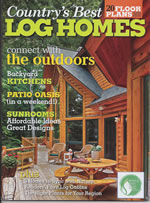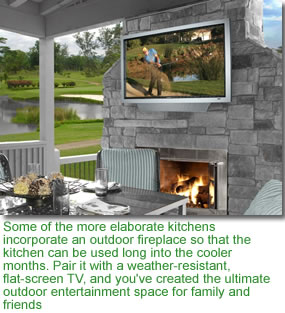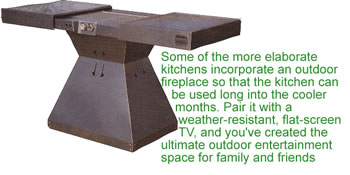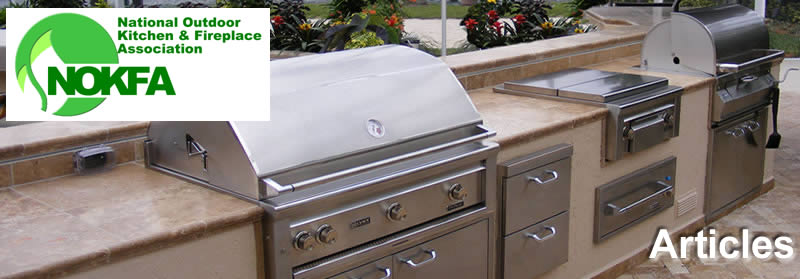Country's Best Log Homes Article on Outdoor Kitchens

NOKFA President, Mark Allen, discusses outdoor kitchens with Country's Best Log Homes
For more information on Country's Best Log Homes resources visit there website (www.countrysbestloghomesmag.com).
“Ten years ago, products for outdoor kitchens were very expensive or simply not available,” explains Mark Allen, president of the National Outdoor Kitchen and Fireplace Association and Outdoor Kitchens by Design. “Now, many manufacturers offer a vast array of accessories, and there are infinite options.”
Although outdoor kitchens may not make sense for everyone, they are perfect for outdoor enthusiasts and those who love to entertain. “The outdoor kitchen trend seems to go hand in hand with the green living trend,” suggests Jan Ledgard of Yorkshire Kitchens in Pasadena, California. “These days many people are trying to bring the outdoors in – or the indoors out – and blend their whole living space into functional space.”
Creating the ideal al fresco entertainment and workspace isn’t difficult – it just entails a little bit of careful planning
.
Design It Right
Today’s outdoor kitchens are a far cry from the simple grilling stations of the past. “We’re seeing designs that are much more grandiose and elaborate – for example, if you incorporate a bar seating area and perhaps an outdoor fireplace, you’ve created the ultimate backyard oasis,” says Allen.
Most outdoor kitchen experts agree that hiring a professional is crucial to a good design. “An outdoor kitchen really needs to be designed, not just built,” Allen explains. “You’ll want to hire a professional who will help you incorporate a cooking zone with plenty of prep areas, a cold zone for under counter refrigeration, and an entertainment or sitting area.”
Licensed professionals will not only help you create a functional layout, they’ll also help you plan the mechanicals—electrical outlets, gas lines, venting and plumbing. In addition, they’ll know when you need permits, and when you don’t, for such items as pergolas, new drains or extensive structural changes.
As for shape and size, every design is individual, but many outdoor kitchen designers recommend L-shaped designs that offer some kind of barrier between guests and the chef. Many of today’s designs boast a comfortable bar area where guests can sidle up to an island for conversation and cocktails. Midsized designs—bigger than a wet bar not as big as the full-size kitchen inside—seem to be the most popular. Some suggest planning at least a 10-by-10-foot space for cooking and prep, and additional space for entertaining.
“Regardless of the dimensions you choose, just make it an open, flexible type of space so that, if you are entertaining, you have enough room for everyone to gather around and congregate,” recommends Matt Franklin, lead architect for PrecisionCraft Log and Timber Homes. “It really should be integrated into the rest of your home, so that it seems to be almost a natural extension of it.”
Where Should It Go?
An outdoor kitchen should be placed in a location that is easily accessible to your indoor kitchen, not only so that it will be convenient to run indoors for ingredients and tools, but also so that you can take advantage of existing plumbing, electrical and gas lines. Ideally, it should be placed on an existing deck or patio under a roofed structure of some sort. (Just be sure to provide proper ventilation.)
“The best option is to set it on a covered lanai so that it’s better protected from the outdoor elements,” says Allen. “If you don’t have a covered location, consider incorporating a pergola over the top of the kitchen.”
Covered settings also provide space for ceiling fans and lighting fixtures, but if a covered  location isn’t feasible, fear not. There are plenty of outdoor kitchens place on open patios these days that function well, thanks to weather-proof appliances and solutions. location isn’t feasible, fear not. There are plenty of outdoor kitchens place on open patios these days that function well, thanks to weather-proof appliances and solutions.
In the end, the best place for your outdoor kitchen is what works for you. “It really depends on how you live in your space,” Legard explains. “What do you cook? How do you cook and store food? Do you want your outdoor kitchen right outside your indoor kitchen or with an expansive deck in between? Go with whatever is most practical for your lifestyle.”
The Right Stuff
Because outdoor are exposed to the elements, different considerations come into play in terms of materials. Weatherproof cabinetry and countertops that can hold up against rain, sun and extreme temperature variations are essential. This is especially critical if your outdoor kitchen isn’t covered.
For cabinetry, the top two options are polymer and stainless steel; both are incredibly weather-resistant. A third alternative is masonry cabinetry built from cement blocks or a metal frame covered in a decorative stone, stucco or brick veneer. The only downside to building with concrete block: It takes up a good portion of your cabinets’ interiors.
If you have your heart set on wood, you might consider cabinets that feature teak or cypress doors within a weather-safe polymer cabinet box. “Wood can present some mildew issues and potentially be a fire hazard, so you want to avoid overusing it in an outdoor kitchen, “Allen advises.
For countertops, consider natural stone, granite, porcelain tile, slate or concrete. Keep in mind that some darker concrete hues could be subject to fading or yellowing under extreme sun exposure, so you may want more neutral, earthy tones if you opt for concrete.
As for appliances, always opt for those that are specifically manufactured for outdoor use. Experts recommend 304-grade stainless steel. In addition, you can take extra precautionary measures to protect your outdoor kitchen from the elements. For example, you can purchase protective covers similar to boat covers; you can add a preservative, such as Sheila Shine, to your appliances; and you can cap off hoods so that rain cannot get in.
“It’s also critical that you winterize outdoor water lines,” Franklin advises.
What’s Hot
Today’s elaborate designs incorporate outdoor refrigeration, sinks, built-in grills, fiber-optic lighting, fireplaces, beer dispensers, wine chillers, ice makers, and even all-weather LCD televisions and wood-fired pizza ovens. In addition, outdoor cabinets feature everything from built-in storage and pullout butcher blocks to dazzling center islands.
“We’re seeing much more accessible storage in today’s designs,” shares Ledgard. “Outdoor kitchens have become a true extension of our indoor kitchens.”
Some manufacturers offer pre-fabricated islands designed for outdoor kitchens, but many experts recommend custom designs. “The ‘boxed’ island is limited as to what it can do.” Allen  explains. “It can be challenging to work it into your existing dimensions, and it often looks like it never really fits.” explains. “It can be challenging to work it into your existing dimensions, and it often looks like it never really fits.”
Perhaps the most important ingredient of the outdoor kitchen is the grill itself. Today’s models feature side burners, multizone cooking capability, integrated shelving and storage, rotisserie attachments, warming racks and more. Some high-end models even boast a hybrid cooking drawer that allows you to cook with charcoal, wood and gas, all on one grill.
Of course, some homeowners yearn for something less complicated, such as simply cooking over an open flame. In that case, consider a fire pit where guests can circle around and join in on the cookout fun. Other “back-to-basics” options include the Big Green Egg (a ceramic cooker) or an Indian clay oven. Simplicity can also be found in your outdoor kitchen surroundings.
“I encourage my clients to plant a kitchen or herb garden nearby or in containers on the deck,” says Ledgard. “This way, when you need herbs while you are cooking, they are right there at your fingertips.”
Tech Talk
If your outdoor kitchen is covered or semi-covered, you’ll need to incorporate a hood to vent out fumes and smoke. Also, unless you’re building a house from scratch, you’ll need to take existing mechanicals into account. (That’s why it’s a good idea to place your outdoor kitchen close to your existing home.)
“Adding an outdoor kitchen to an existing house isn’t a big deal, as long as you hire a professional designer-builder who knows how to specifically design and build outdoor kitchens,” says Allen. “Adding electrical and gas lines isn’t too bad, but adding a drain for the sink is a bigger issue. Some counties require you to tie the outdoor kitchen drain into the official waste line, requiring a permit to do so.”
An alternative is to opt for a cold-water sink that is never used for food waste. “Then you can have gray water runoff via a French drain, where water runs underground and disperses,” Ledgard explains. The gray water can then be recycled for use in the garden.
Also consider having “on-demand” hot water that is heated with a small water heater; it’s usually cheaper than running hot water lines. If you really want to keep it simple, choose cold water only with the “bucket under the sink” method to collect water waste. (Just remember to regularly empty the bucket.)
Simple or complex, outdoor kitchens are showing up in all types of climates and settings these days. Not too long ago, only Floridians and other warm-weather residents enjoyed such spaces. Today, even Alaskans are enjoying these outdoor havens.
“The idea of outdoor kitchens has definitely caught on in colder climates,” says Allen. “The window of opportunity may be smaller, but outdoor fireplaces extend the usability of the outdoor kitchen.”
A gas patio heater may also help extend the kitchen’s usability. Whether you plan to use it year-round or not, make sure you properly winterize your setting. You can insulate pipes and other lines as well as use frost-proof faucets. And even if you opt for a cold-water supply line for your sink (which can be a simple garden hose, in warmer months), make sure you install a shutoff valve inside your home so that you can drain the line during the winter. CBLH
(Reprinted from Country's Best Log Homes, May 2010)
|


 location isn’t feasible, fear not. There are plenty of outdoor kitchens place on open patios these days that function well, thanks to weather-proof appliances and solutions.
location isn’t feasible, fear not. There are plenty of outdoor kitchens place on open patios these days that function well, thanks to weather-proof appliances and solutions. explains. “It can be challenging to work it into your existing dimensions, and it often looks like it never really fits.”
explains. “It can be challenging to work it into your existing dimensions, and it often looks like it never really fits.”


